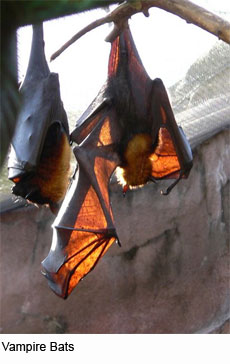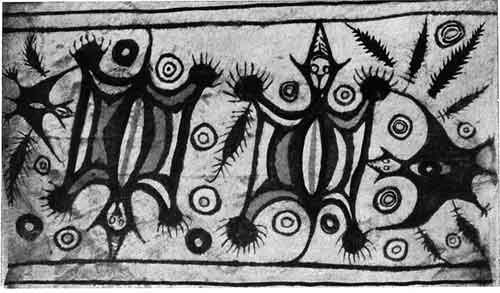|

The Nose Knows: Unlike Fruit-eating bats, the Vampire bats have a short, conical muzzle without a nose leaf. Instead they have naked pads with U-shaped grooves at the tip. The common vampire bat also has specialized infrared sensors on its nose. A nucleus has been found in the brain of vampire bats that has a similar position and has similar histology to the infrared nucleus of infrared sensitive snakes.

A Liquid Diet: They have small ears and a short tail membrane. Their front teeth are specialized for cutting and their back teeth are much smaller than in other bats. Their digestive systems are also specialized for their liquid diet. The saliva of Vampire bats contains a substance, draculin, which prevents the victim's blood from clotting. They, therefore, lap blood rather than suck it as most people imagine.
 They Come Out at Night: They come out to feed only when it is fully dark. Like Fruit-eating bats, and unlike insectivorous and fish-eating bats, they only emit low-energy sound pulses. The Common Vampire bat feeds mostly on the blood of mammals, whereas the Hairy-legged Vampire bat, and the White-winged Vampire bat feed on the blood of birds. They Come Out at Night: They come out to feed only when it is fully dark. Like Fruit-eating bats, and unlike insectivorous and fish-eating bats, they only emit low-energy sound pulses. The Common Vampire bat feeds mostly on the blood of mammals, whereas the Hairy-legged Vampire bat, and the White-winged Vampire bat feed on the blood of birds.
Once the common Vampire bat locates a host, usually a sleeping mammal, they land and approach it on the ground. A recent study found that common vampire bats can, in addition to walking, run at speeds of up to 1.2 meters per second. They possibly locate a suitable place to bite using their infrared sensors.
Problem Pee: The feeding pattern of the vampire bat adds a layer of complexity to its anatomy.
Because they often do not find host organisms for many hours and may have to fly a long distance to do so, vampire bats usually feed in enormous quantities. This influx of proteins may make the bat too heavy to fly. Accordingly, the bat's urinary system accommodates this by releasing dilute urine consisting of a lot of water and fewer solutes. However, when the bat is resting, a new problem is faced. The large amounts of protein create excess urea and must be disposed of. The urinary system of the vampire bat then uses various hormones to make concentrated urine -- consisting of more urea and less water.
Blood Transfusion: Vampire bats tend to live in almost completely dark places, such as caves, old wells, hollow trees, and buildings. Colonies can range from a single individual to thousands. They often roost with other species of bat. They will almost always have only one offspring per breeding season.
 Each colony will typically contain only one reproducing male, with around twenty females and their offspring. They need blood at least once every few days Each colony will typically contain only one reproducing male, with around twenty females and their offspring. They need blood at least once every few days
to survive. If they can't get blood, they'll approach another vampire bat whilst roosting, asking for a blood 'transfusion'. The blood is exchanged mouth-to-mouth in a motion that looks very much like
kissing. Vampire bats can live up to 9 years in the wild and up to 19 in captivity.
Mixed Bag: Vampire bats are common carriers of the deadly rabies virus
which, aside from its danger to humans,
is responsible for the deaths of many thousands of farm animals each year in tropical and sub-tropical America. However they do have some benefits, in a study which appeared in the January 10, 2003 issue of Stroke: Journal of the American Heart Association, a genetically engineered drug called desmoteplase based on the saliva of Desmodus rotundus was shown to improve stroke patients.

3 of a Kind: The three species are quite different from each other, and are therefore placed within different genera (no other species are currently classified in any of the three genera concerned). But they are related. In older literature, the three genera are placed within a family, Desmodontidae, but this is now regarded as unhelpful, as it hides the similarities the Vampire bats have with other members of the American leaf-nosed bat family, Phyllostomidae. They are therefore now grouped as a subfamily, the Desmodontinae within the Phyllostomidae. The fact that the three known species of Vampire bat all seem more similar to one another than any of them is to any other species suggests that sanguivory (feeding on blood) only evolved once, and that all three species share a common ancestor.

All text is available under the terms
of the GNU Free Documentation License
|

